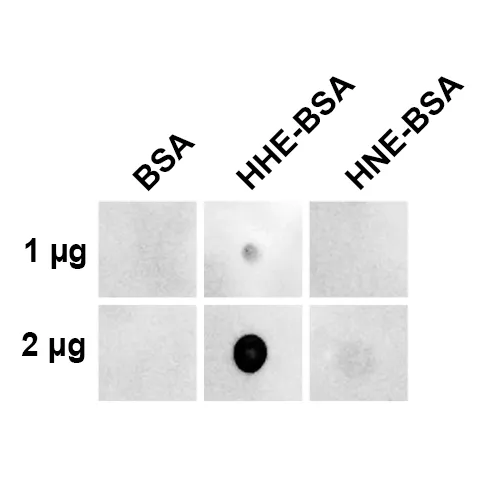4-Hydroxy-2-hexenal Antibody
- Availability: 24/48H Stock Items & 2 to 6 Weeks non Stock Items.
- Dry Ice Shipment: No








4-Hydroxy-2-hexenal Antibody
Background:
Lipid peroxidation occurs when oxidizing agents attack carbon-carbon double bonds found in unsaturated lipids. In addition to membrane degradation, oxidation end-products have been found to damage cell viability through their mutagenic and toxic properties. These downstream functional consequences facilitate the development of disease and premature aging. 4-hydroxy-2-hexenal (4-HHE) is a major alpha,beta-unsaturated aldehyde product of n-3 PUFA oxidation resulting from lipid peroxidation. High levels of HHE are found in disease states (1). 4-HHE reacts with histidine residues to form Michael-addition type adducts.Description:
Mouse Anti-4-Hydroxy-2-hexenal Monoclonal IgG1Specifications:
Specific for 4-Hydroxy-2-hexenal. Slight cross-reactivity with 4-Hydroxynonenal. Does not cross-react with Acrolein, Crotonaldehyde, Hexanoyl Lysine, Malondialdehyde, or Methylglyoxal modified proteins.Product Name Alternative:
4-Hydroxy-2-hexenal (4-HHE) Antibody, 4-Hydroxy-2-hexenal Antibody, 4-HHE Antibody, MG Antibody, MG-modified protein Antibody, 4-Hydroxy-2-hexenal-modified , 4-Hydroxy-2-hexenal Antibody, 4-hydroxy Hexenal Antibody, HHE Antibody, 4-HHE AntibodySynonyms:
4-Hydroxy-2-hexenal Antibody, Clone 5C11.1UNSPSC:
12352203Host:
MouseSpecies Reactivity:
Species IndependentImmunogen:
Synthetic 4-Hydroxy-2-hexenal modified Keyhole Limpet Hemocyanin (KLH)Target:
4-Hydroxy-2-hexenalClonality:
MonoclonalIsotype:
IgG1Clone:
5C11.1Conjugation:
UnconjugatedValidated Applications:
WB, ELISAPurification:
Protein G PurifiedLimit Of Detection:
A 1:1000 dilution of SMC-536 was sufficient for detection of 4-Hydroxy-2-hexenal in 1 µg of 4-Hydroxy-2-hexenal-BSA conjugate by ECL immunoblot analysis using goat anti-mouse IgG:HRP as the secondary antibody.Concentration:
1 mg/mlDilution:
WB (1:1000); ELISA (1:1000); optimal dilutions for assays should be determined by the user.Weight:
0.012Buffer:
PBS pH7.4, 50% glycerol, 0.09% sodium azidePrecautions:
Not for use in humans. Not for use in diagnostics or therapeutics. For in vitro research use only.References & Citations:
1. Long, EK., Picklo, MJ Sr. (2010) Free Radic Biol Med. 49(1):1-8.CAS Number:
9007-83-4
MSDS Document
View Document